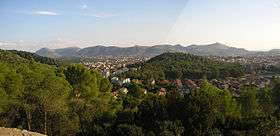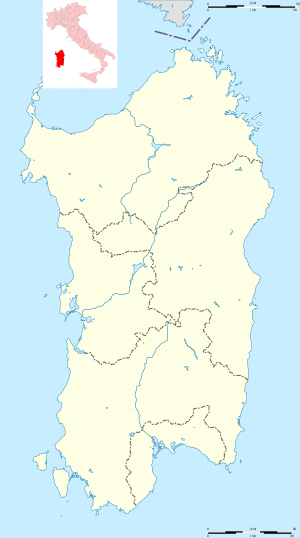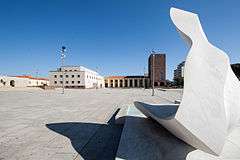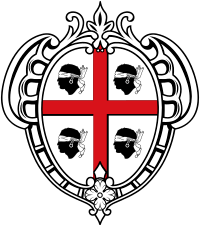Carbonia, Sardinia
| Carbonia | |
|---|---|
| Comune | |
| Comune di Carbonia | |
 panorama | |
 Carbonia Location of Carbonia in Sardinia | |
| Coordinates: 39°10′2″N 8°31′20″E / 39.16722°N 8.52222°E | |
| Country | Italy |
| Region | Sardinia |
| Province | South Sardinia |
| Frazioni | Bacu Abis, Barbusi, Cannas, Corongiu, Cortoghiana, Genna Corriga, Flumentepido, Is Gannaus, Is Meis, Medadeddu, Medau Desogus, Serbariu, Sirai, Sirri |
| Government | |
| • Mayor | Paola Massidda |
| Area | |
| • Total | 145.54 km2 (56.19 sq mi) |
| Elevation | 111 m (364 ft) |
| Population (31 December 2017)[1] | |
| • Total | 28,265 |
| • Density | 190/km2 (500/sq mi) |
| Demonym(s) | Carboniesi or Carboniensi |
| Time zone | UTC+1 (CET) |
| • Summer (DST) | UTC+2 (CEST) |
| Postal code | 09013 |
| Dialing code | 0781 |
| Patron saint | St. Pontian |
| Saint day | Third Thursday of May |
| Website | Official website |
Carbonia (pronounced [karˈbɔːnja] ![]()
History

Carbonia was officially inaugurated on the 18 December 1938 by the Fascist regime. Benito Mussolini ordered the building of the city and was present at its inauguration. The city was built in order to provide housing for the workforce of the nearby mines. The name "Carbonia" comes from the Italian word for coal, a resource that is abundant in this area.
The city grown considerably since its birth in 1938, due to mass immigration of people from the rest of the Island and mainland Italy (in particular from the regions of Veneto, Sicily, Abruzzo, Marche, Basilicata and Campania), reaching about 45,000 residents in 1951. Currently it has a population of over 28,000 inhabitants.
Since the mines' closing during the 1970s, Carbonia has had to deal with a high unemployment rate. After the closure of the mines the town's economy was converted on the metallurgical industry, so today most Carbonians find their employment in the heavy industry, but also in the tertiary sector.
Main sights
- Monte Sirai, a hill in the surroundings of the city that hosts the ruins of a Phoenician-Carthaginian built-up area
- Domus de janas in the surroundings of Sirri and Monte Crobu
- Romanesque church of Santa Maria di Flumentepido (11th century)
- Former Serbariu coal mine, now turned into a museum and a site of industrial archaeology
International relations
Carbonia is twinned with:




References
External links
| Wikimedia Commons has media related to Carbonia. |
